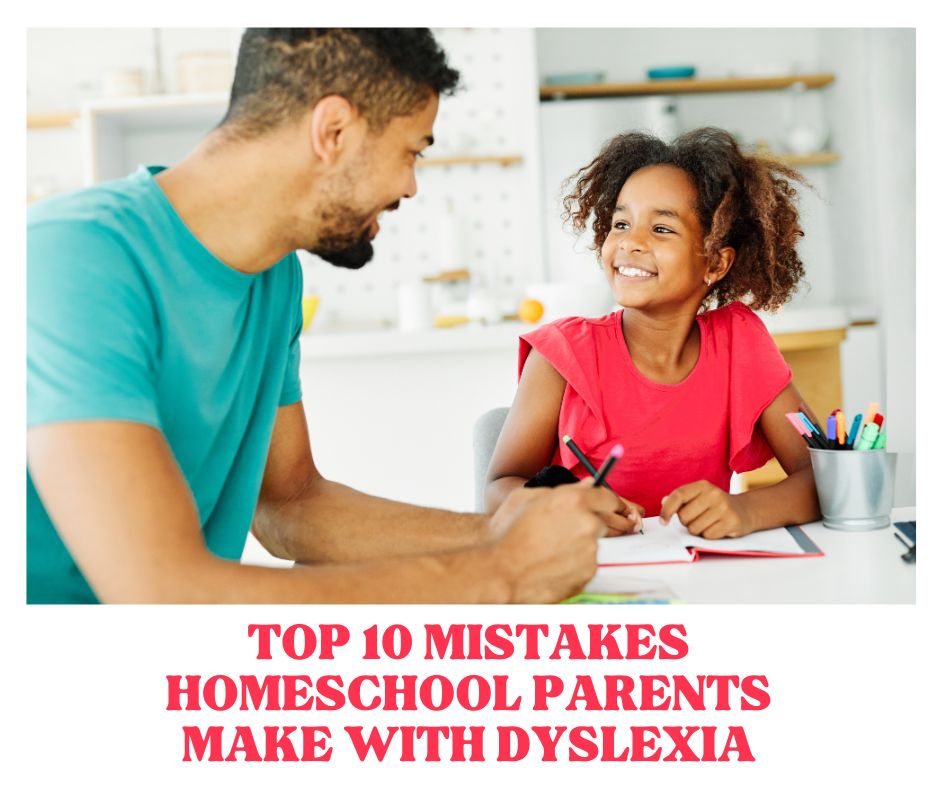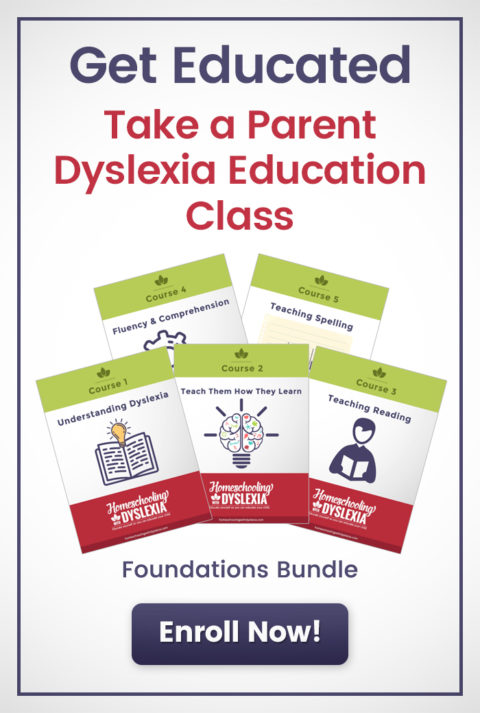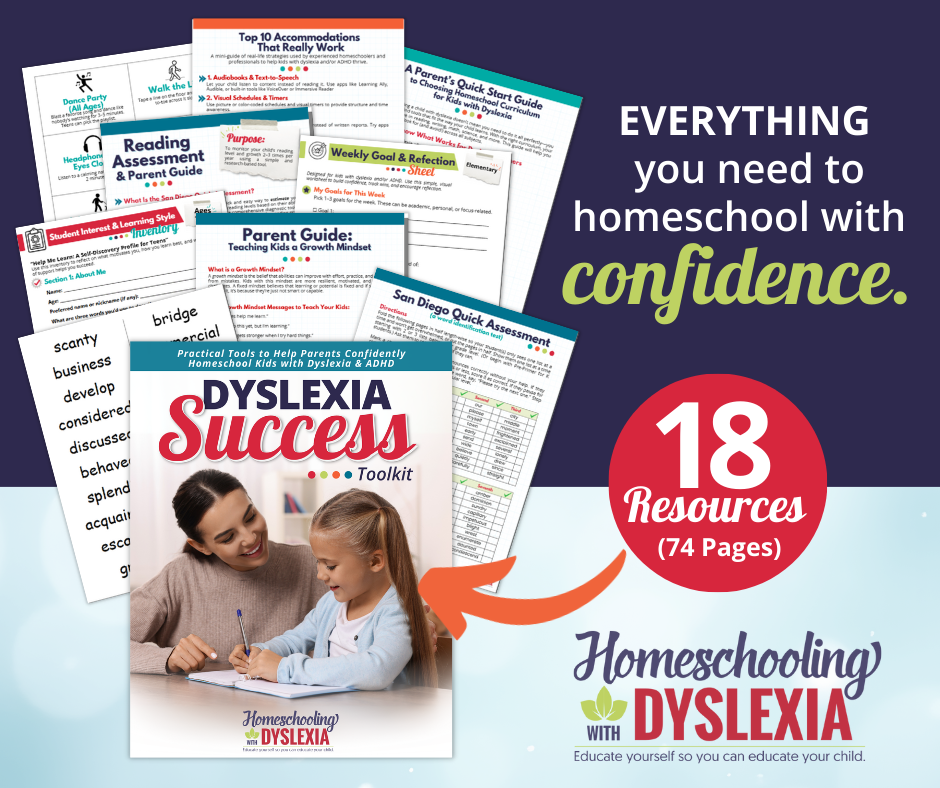Homeschooling children with dyslexia and ADHD presents unique challenges and opportunities. As a veteran homeschool mom of 7 kids with learning differences like dyslexia and ADHD, with 30 years of experience teaching my smart but struggling kids at home, here are the top 10 mistakes I see parents make—and how to avoid them.

1. Trying to Recreate Traditional School at Home
Many homeschool parents attempt to mimic conventional classroom settings, which can be counterproductive for neurodiverse learners. The reason we do this, even when our gut tells us it may not be the best thing for our kids, is because the structure of a traditional classroom is all we know! The traditional school model feels safe and way more comfortable than creating an individualized program specifically for our unique kids.
There is a reason (many reasons, actually) why traditional school schedules, curriculum, and goals don’t work well with kids with dyslexia. I encourage you to embrace the flexibility of homeschooling by tailoring the environment, curriculum, and expectations to one that best meets your child’s needs, incorporating interests, movement, hands-on learning, and frequent breaks, if needed. Read, Why Parents are qualified to Teach Their Kids With Dyslexia, here.
2. Having Unrealistic Expectations
Kids with dyslexia often master reading much later than neurotypical students – sometime not becoming fluent readers until they are 12 years old, or older. This is 100% normal! Allowing our kids to learn at their own pace is one of the biggest benefits of homeschooling. Embrace the freedom to teach your kids at their pace with methods and curricula that work and give them the gift of an education that meets their real learning needs.
3. Focusing too Much on ‘Catching up’ or ‘Fixing’ Your Child
Focusing solely on areas of difficulty can erode a dyslexic child’s confidence, and also make mom and dad anxious. The best approach to teaching struggling learners at home is to teach them at their level with resources and methods designed for their unique brain wiring. Recognize and nurture your child’s strengths, whether in art, music, or problem-solving, to foster a positive learning experience.
One of the most important things you can do as a parent of a child with dyslexia is to understand dyslexia. Dyslexia is a brain wiring difference that causes people to struggle to master, process, and understand written language. Dyslexia is not a lack of intelligence and is not something that is ‘cured’. Dyslexia can be remediated and all people with dyslexia can learn to read in time with the right methods. Read Dyslexia: A Learning Difference or Disability?
4. Using the Wrong Kinds of Curricula
There is a reason why traditional schools routinely fail to meet the educational needs of kids with dyslexia. Traditional curricula often do not have the multi-sensory, tailored approach with which students with dyslexia truly thrive. Specialized programs that include hands-on or multi-sensory learning options, audio and video resources, or that provide for individualization and plenty of review, work better with neurodivergent students. Sign up to receive my free dyslexia-friendly homeschool curriculum guide here.
5. Refusing to use Assistive Technology
Tools like audiobooks, speech-to-text software, and organizational apps are NOT cheating and can significantly aid learning for students with dyslexia. Assistive technology allows students who may not be reading and spelling fluently (yet) to read and write at their intellectual abilities. Think about it. When you can’t spell a word, what do you do? You choose another word that is easier to spell but may not have the same impact. Allowing kids with dyslexia to listen to books in an audio version makes interesting, engaging literature accessible to them. Integrating technology makes learning more accessible and engaging. Download our free Guide to Assistive Technology.
6. Not Using Accommodations and Modifications
Accommodations and modifications are tools that help homeschooled students with dyslexia learn in ways that match how their brains work best. Accommodations change how a student learns (like using audiobooks or speech-to-text), while modifications change what they are expected to learn (like simplifying assignments or reducing reading load). These supports aren’t “cheating”—they level the playing field so kids can show what they know without being held back by reading struggles. Parents shouldn’t be afraid to use them; they are a normal and effective part of teaching kids with dyslexia at home and can build confidence, reduce frustration, and lead to real progress.
7. Ignoring the Need for Deschooling
Transitioning from traditional schooling to homeschooling requires an adjustment period. Many kids come out of the traditional school setting having experienced a lot of stress and pressure. Allow time for your child to decompress and adapt to new learning methods without the pressures of conventional academic expectations. Learn more about how to implement a time of deschooling into your child’s routine here.
8. Succumbing to Comparison
Somehow, becoming a homeschool parent of a struggling learner propels us back to the middle school mindset of comparison. It’s normal and natural to compare your homeschool to other homeschools, whether that is through online homeschool blogs or in-person homeschool friends. Comparing your child’s progress to peers can lead to unnecessary stress. Every child learns at their own pace; celebrate individual milestones and growth. It is important to find other families that are also homeschooling struggling learners. See #10 below for ideas on how to find homeschool support.
9. Overloading with Academics
Pushing too hard academically, especially in the elementary years, can lead to burnout. One of the most impactful benefits of homeschooling a child with dyslexia is being able to adjust your teaching to meet their needs. Focusing primarily on weaknesses and striving to catch up put too much pressure on kids. Balance structured learning with play, exploration, and pursuing interests to maintain enthusiasm and well-being. A homeschool parent’s focus should be on progress being made and not primarily on catching up or eliminating all learning struggles.
10. Underestimating the Importance of Support Networks
Homeschooling can be isolating without a support system. Engage with communities, both online and offline, to share experiences, resources, and encouragement. See this post on finding support groups for more information.
While parental involvement is crucial, consulting with specialists can provide additional strategies and insights. Don’t hesitate to seek external expertise when needed .
For more in-depth guidance, my book, No More School: Meeting the Educational Needs of Kids With Dyslexia and Language-Based Learning Difficulties, helps parents learn to let go of the desire to fit our kids into the traditional school model and offers practical ways to offer kids with kind of support and teaching they really need.
Need some hand holding this school year? Join me and my monthly mentoring group. We meet twice a month live on Zoom to share our successes and get help for our struggles.
Remember, homeschooling is a journey. With patience, adaptability, and the right resources, you can create a nurturing and effective learning environment for your child.
Related Posts
10 Reasons to Homeschool With Dyslexia
8 Things to Know Before you Homeschool your kids with Dyslexia






0 Comments